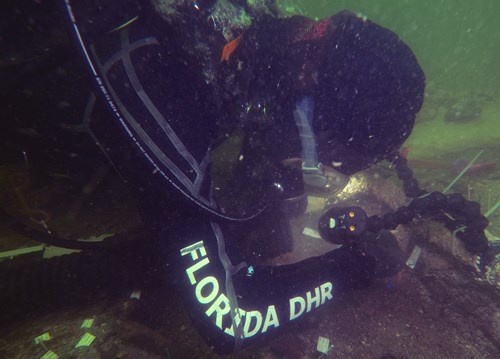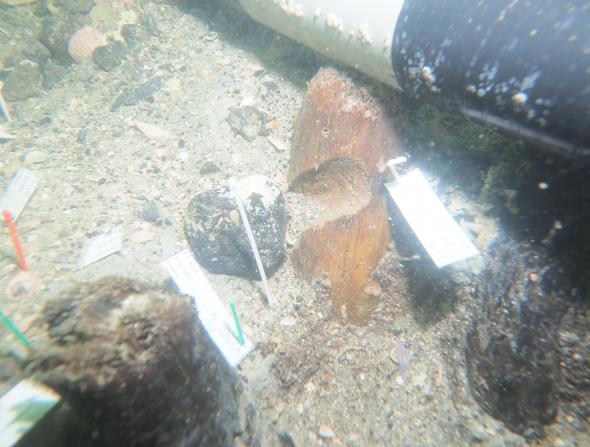
Manasota Key Offshore Archaeological Site
- Our Initiatives
- Manasota Key Offshore Archaeological Site
An unexpected discovery by a fossil hunter diving just off Manasota Key near Venice, Florida, has led to a groundbreaking archaeological project that could change everything scientists thought they knew about offshore archaeology. The Manasota Key Offshore site, as archaeologists from Florida’s Department of State named it, will help researchers better understand how Florida’s earliest people lived and what their landscape looked like. It also adds to a constellation of fascinating prehistoric sites that have been discovered along the Gulf Coast in Sarasota County.

The Discovery
An amateur diver first reported possible human remains in the waters off Manasota Key to the Department of State’s Bureau of Archaeological Research (BAR) in June 2016. Through non-invasive underwater survey and investigation techniques, BAR's underwater archaeologists soon documented evidence of a prehistoric Native American burial site in what appears to have been a freshwater, peat-bottomed pond thousands of years ago.
Read more about the site in this National Geographic story >>
Ongoing investigation revealed the remains of multiple individuals and artifacts including wooden stakes that were used in burial practices. Radiocarbon analysis of two stakes dated them to more than 7,200 years old.
When this site was in use, the waters of the Gulf of Mexico were about 30 feet below their current level. Given the site’s depth today—under about 21 feet of water—the pond would have sat on dry land some nine feet above sea level at the time! Despite the flooding of the site thousands of years ago, the peat bottom remained intact. Peat slows the process of organic decay, which allowed the site to stay well preserved.
Globally Significant

Florida’s archaeological record already includes evidence of pond burials from around the same time period at several sites, including the well-known Windover site in Titusville and Little Salt Spring here in Sarasota County. What makes the Manasota Key Offshore site remarkable is its location and the evidence it provides that will allow scientists to recreate the prehistoric environment, including ancient springs and rivers. The Manasota Key Offshore site is the first preserved prehistoric burial site in the Americas to be discovered in offshore waters, and one of just a few such sites known in the world.
The discovery demonstrates that submerged offshore archaeological sites have survived sea-level rise and other natural occurrences, such as erosion and hurricanes. This revelation opens up the possibility that the Gulf of Mexico could contain other preserved archaeological sites that were once on land but are now submerged.
The site is also unique because of its exceptional preservation and age. It is the final resting place for numerous ancestors of Florida’s indigenous people. As the state continues to document and research the site, we will gain a deeper understanding of Florida’s early history and its inhabitants.
Regionally Transformative
“The Manasota Key Offshore site is one of several significant archaeological discoveries along the Gulf Coast in Sarasota County that illuminate what life was like for the first Floridians,” notes John McCarthy, executive director of Historic Spanish Point and a member of the local project team assembled by Gulf Coast Community Foundation to assist the state in protecting and learning from the newly discovered site. “Like Warm Mineral Springs, Little Salt Spring, and others, the Manasota Key Offshore site provides a glimpse of Florida as it was several thousand years ago."
“Through extraordinary circumstances, the evidence left behind by Florida’s early people 7,000 years ago has been preserved,” McCarthy continues. “This fragile site is tremendously significant for understanding both the environment that supported Florida’s first people and the lives and culture of the people themselves.”
At Gulf Coast Community Foundation, one of our regional priorities is "enhancing our unique places." Protecting and learning from this invaluable archaeological discovery in the most innovative ways possible will simply add to what makes our communities and natural areas so special.
Protection and Partnership
The Manasota Key Offshore site presents a unique set of management challenges.
Given its proximity to Venice, which is a well-known fossil hunting destination, the site is in danger of intentional and unintentional disturbance by avocational divers. Long-term site plans emphasize protecting this delicate submerged landscape and developing appropriate techniques to ensure the respectful protection of the individuals buried there.
The site is protected under Florida law, and it is illegal to excavate or remove any material or human remains from it. Section 267.13, Florida Statutes, makes it a first-degree misdemeanor to remove artifacts from an archaeological site without authorization. Section 872.05, Florida Statutes, makes it a third-degree felony to knowingly disturb, destroy, remove, vandalize, or damage a human burial.
The Secretary of State requested that Gulf Coast Community Foundation take a lead role in convening regional partners and community stakeholders in support of the long-term plan for the site. Gulf Coast has worked with the State Department to bring together a diverse group of research, educational, cultural, and civic organizations that can support the immediate objectives of protection and preservation and help plan for future interpretation and education activities.
In addition to research and law-enforcement partners that are working with the state, local partners providing input and expertise include:
• DreamLarge
• Gulf Coast Heritage Association/Historic Spanish Point
• Ringling College of Art and Design
• Sweet Sparkman Architects
• Venice Museum & Archives
• Manasota Key homeowners’ associations
